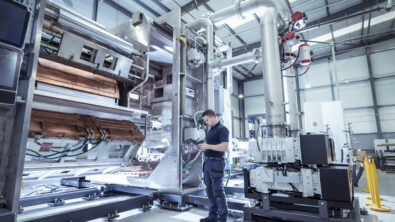Smart manufacturing provides a competitive advantage

The innovations across the landscape of industrial machinery in manufacturing are witnessing a phenomenal overhaul of technological progressions. As a result, it can be challenging to validate and manage modern manufacturing and assembly operations to optimize cost and optimum quality.
However, machinery manufacturers are gaining a competitive advantage by implementing smart manufacturing. This blog outlines how machine manufacturers maximize profits and the industry trends driving the acceptance of this groundbreaking technology.
Smart manufacturing and a digital twin
Smart manufacturing provides a digital twin of the device, but that’s just one aspect of it. Also, it extracts the digital twin information and drives it into manufacturing operations, like CNC programming or inspection and driving the assembly processes. Therefore, that data is pushed back into the digital twin, making an executable digital twin of the product or process.
There is an ongoing inspection process in making the machine tool and driving that back into the inspection data and then back into the product’s digital twin. Thus, there is traceability from the design to manufacturing and a closed-loop process that provides a whole digital twin. Siemens’ focus is on industrial machinery in this process, essentially seeing how the digital twin of the product and the machine are linked together.
Software solutions stay ahead of competition
Siemens is in a unique position on the software side due to its association with Siemens AG. It is one of the largest manufacturing companies on the planet. Therefore, they are always looking for opportunities to optimize manufacturing processes and earn more profit from every process executed. Also, they provide a stable testbed for manufacturing operations and execution management software solutions.
As a leading provider of industrial automation for many years and being the most significant industrial automation supplier globally, they understand the inherent need for technology integration into machinery. They provide a high-quality function in the industrial automation process. By manufacturing those components, they know what companies need from a machinery development perspective and what is necessary to execute to stay ahead of the competition.
Software is necessary to realize every step in the manufacturing process, from creating the idea to what is being made from machinery and executing it through manufacturing and extending that into service life. This process is essential for a machine builder because it allows machine manufacturers and designers to create more value in driving down cost and compressing delivery schedules. It also provides faster innovation by closing the loop between manufacturing operations and engineering.
Industrial machinery trends
There are some overarching themes and trends in machinery development over the last several years, and they circulate four topical areas:
- Connected customers expect that machines will be communicating with other machinery in the plan – communicating with the primary operating system and the machine OEMs.
- Adaptability reflects how quickly the machine modifies its existing operating parameters and reacts to changing conditions. There is much information, sensors, and capabilities available, so the machine can recognize when upstream products and processes have changed to upgrade those changes to its operating conditions automatically.
- Predictability is essential with various operating conditions and unpredictable customer environments, creating an increased emphasis on simulation and the predictability of how a machine will perform in the field. This issue is crucial at higher speeds, with various use cases and enhanced complexity of machinery.
- Extendability is crucial as machine builders want to extend the machine’s life through the customer facility and its entire lifespan. Similarly, from a financial perspective, creating more value for the customer and modifying some of the dynamics behind the cash flow to extend the life of the machine through predicted maintenance and adaptive performance.
Previously, a company bought a machine that operates throughout a certain lifespan and then the product changes, either from the supplier or the customer. Therefore, the customer must purchase something to adapt that machine to fit the new product or replace it. So, we are witnessing machine complexity being incorporated with changing conditions with shorter production runs from a customer perspective.
Similarly, customers are less willing to invest substantial amounts in machinery when they could use production as a service option, allowing them to buy machine capacity. This emerging trend is becoming popular with heavy equipment manufacturers when leasing machines. The difference is in paying for performance. So, if that machine isn’t running, they are not paying for it. The machine builder, or OEM, has a vested interest to ensure the device always works. Therefore, if it’s not meeting the production requirements – it needs service – then the OEM is financially responsible for rectifying any performance problems or downtime issues and addressing them quickly to restore their cash flow.*
*To learn more about the competitive advantages to smart manufacturing for industrial machinery, listen to or read the archived first podcast or blog that this post is based on.
Siemens’ software solutions
Siemens’ Xcelerator portfolio helps companies of all sizes create and leverage digital twins that provide organizations with new insights, opportunities, and automation levels to drive innovation.
For more information on Siemens Digital Industries Software products and services, visit siemens.com/software or follow us on LinkedIn, Twitter, Facebook and Instagram.
Siemens Digital Industries Software – where today meets tomorrow
We always look forward to offering new perspectives on smart manufacturing, so stay tuned for more innovative, insightful blogs and podcasts on this topic in the near future.
Related links:
Smart manufacturing podcast transcript – ep. 1 – Q&A source


